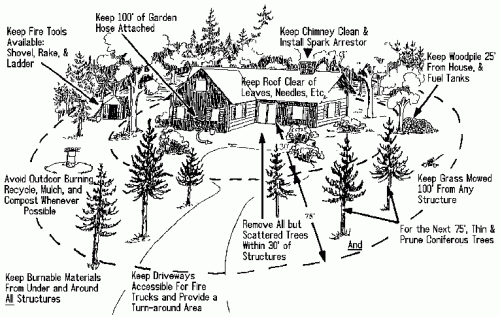Firewise tips on protecting your home from wildfire
In many areas of Northern Michigan, the recent warm weather and winds have caused the snow cover to evaporate quickly.
The recent bout of unseasonably warm weather and high winds across Northern Michigan over the last few weeks has caused the snow cover to quickly evaporate from our forest and fields. The result is much of our northern landscape is in danger of catching fire as the dead, brown vegetation from last year as well as fallen branches from unusually heavy, wet snow in March has created hazardous burning conditions in many areas.
While the Michigan Department of Natural Resources and U.S. Forest Service prepare their fire-fighting crews to battle spring wildfires, what are you doing to protect your home and personal property from wildfires?
As you scan the horizon for the telltale signs of smoke from wildfires, perhaps you should also scan your property to see if your home and other personal property are in good condition to minimize damage from spreading flames and embers from wildfires. The Michigan State University ExtensionFirewise program offers homeowners some of the following tips on wildfire safety for their homes.
Residents can reduce the risk of their home’s ignition by simply modifying their homes and immediate surroundings. For example, clearing a space around the home can reduce wildfire threat. Even something as simple as cleaning gutters and eaves of leaves and debris can prevent an ember from igniting a home.
Firewise landscaping also involves changing, reducing, or eliminating the amount or type of fuel near your building by creating a fuel break. The fuel break should be around all buildings and be at least 30 feet wide, with more width on the downhill side of a slope. Clear a three foot strip around the outside of each building, right down to sand or gravel (mineral soil). This cuts down on the threat of a surface fire burning across the strip and reaching the building. This strip is the first section of your fuel break. If you absolutely need to mulch this strip, use non-flammable types of mulch such as rocks, gravel or pea-stone. Away from the building itself, a green lawn or a rock garden are also good fuel breaks. Grass must be kept watered and cut, and dead grass removed.
Trees in the 30 foot fuel break should have all branches removed up to a height of 6 to 10 feet to prevent ground fires from “laddering” up into the tree crowns. Given the amount of broken and downward leaning conifer tree branches from the heavy snow in late March across Northern Lower Michigan, homeowners should be especially vigilant to remove any branches that could cause fires to easily move up into their tree crowns. (For more information, visit firewise.org.)
These wildfire safety protection measures and others are illustrated in the following graphic attached to this article.




 Print
Print Email
Email



